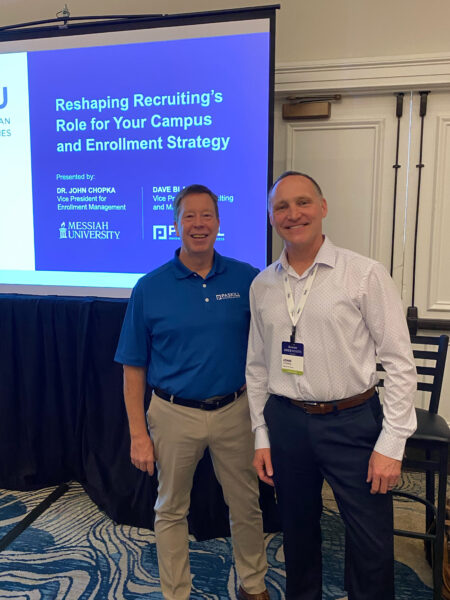Position Your Team for Enrollment Success

Are you doing all you can to position your enrollment team for success? The stakes couldn’t be higher.
HigherEdDive announced on May 3 that “nearly 300 U.S. and foreign colleges have told the National Association for College Admission Counseling that they have open seats for fall 2023.”
Unfortunately, that’s just the next verse in an ongoing song. A November 2022 article in The Hechinger Report noted that “the proportion of high school graduates enrolling in college in the fall after they finish high school has dropped from a high of 70 percent in 2016 to 63 percent in 2020, the most recent year for which the figure is available.”
And it’s not all COVID. As The Hechinger Report explains, there are now 4 million fewer students at colleges and universities than there were in 2012. Other issues at play include demographics, cost, and increasing skepticism regarding the value of a college degree.
College admissions offices are keenly aware of the shifting landscape, yet many have not yet shifted with the changes.
It’s time they do. Dave Black, Paskill’s vice president of consulting and market research, and Dr. John Chopka, vice president of enrollment management at Messiah University, offered some powerful advice during their February presentation at the Council for Christian Colleges & Universities Multi-Academic Conference in Miramar, Florida.
Bottom line? This changing environment demands a new approach to staffing, training, and retaining your enrollment team.
1. Institutions need to revisit their admissions counselor job description and better define the role and expectations.
You can’t hire effectively without revisiting the needs and expectations you have for a top performer in this role. It isn’t enough to hire a recent grad with a love of travel and a passion for the school.
Success in academic sales requires specific skills. By clarifying job expectations, you can make sure the description matches what the counselor will experience on the job. That allows you to more effectively determine the competencies necessary to perform the required job functions.
2. Now that you have a clearer idea of the skills a successful candidate will need, you have to change the way you hire.
Once you know what you are looking for, the hiring process becomes less of a crapshoot. It’s no longer, “Do you have an outgoing personality and an in-depth understanding of our college experience?”
According to Black, it’s more along the lines of “Do you have the time-management skills necessary to effectively perform these responsibilities? Do you know how to build, maintain, and enhance relationships? Do you have the persistence needed to close deals?”
Also, now’s the time to make sure you’re offering a competitive salary and benefits package, as well as an appealing work environment and a real opportunity for advancement. Hiring and retaining walk hand in hand.
3. Once you hire the right people, you have to train them. And then train them more.
Too often, training is about internal processes and tasks such as showing new hires how to work the CRM system and how to file expense reports.
Institutions should also provide competency-based training. Says Black, “You have to ask yourselves, what do we want them to be capable of? If you want them to do A, B, C, and D, you have to train them in the competencies needed to execute A, B, C, and D. Training needs to move beyond how to give a tour and how to set up and manage an admissions event.
4. Now, point them in the right direction.
Too many colleges have lost their way, Black says. While it’s difficult to resist the temptation to go broader geographically, in many cases they are diluting their marketing effort by casting too wide a net and failing to go hard in their own backyard.
Further, they are forgetting the power of relationships, which are especially meaningful given that, as jobs site Zippia reports, 30% of school counselors stay on the job for less than a year, and 59% for less than two years.
Admissions counselors should create additional bonds by regularly visiting local and feeder schools, and by engaging with a variety of student influencers – teachers, coaches, band directors, and advisors for student clubs, organizations, and publications.
Once they parlay these teacher relationships into student relationships, counselors must also reach out to students’ parents, since, as Inside Higher Ed reports, nearly half of students polled rank parents as one of their top sources to learn about the admissions process.
5. Elevate your performance reviews to meet this new, higher standard.
Once you’ve hired the right people, clarified objectives, and provided the right training, you must revise your performance reviews to align with your new expectations.
Essentially, this is a matter of reviewing their goals, assessing their performance against those goals, and either helping them work toward reaching their goals or working with them to establish new goals.
6. The final layer: Career guidance.
This final step, Black says, is essential. Too often the counselor’s role is seen as an entry-level position that they will occupy for 18 to 24 months before moving on. Says Black, “You need to show them they have a career in your institution.”
Black encourages bringing in HR to assign mentors outside the employee’s reporting chain—perhaps the VP or director of marketing or student services. That way, the counselors can see other perspectives on growing professionally, developing teams, and managing and motivating people.
This just scratches the surface. Contact us for a more in-depth look at how you can build a strong, more effective enrollment team.